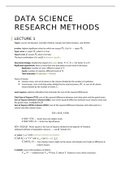Samenvatting
Summary of class notes on Data Science Research Methods (JBM)
This document is a summary of the class notes that are also in this Stuvia. It is more organized and contains all main elements of the lectures and reading material.
[Meer zien]




